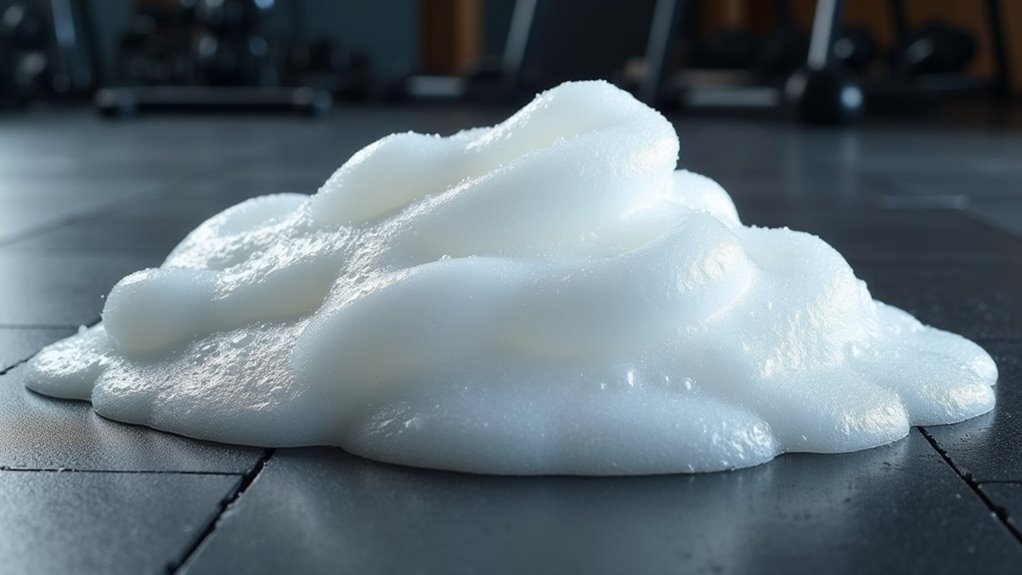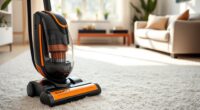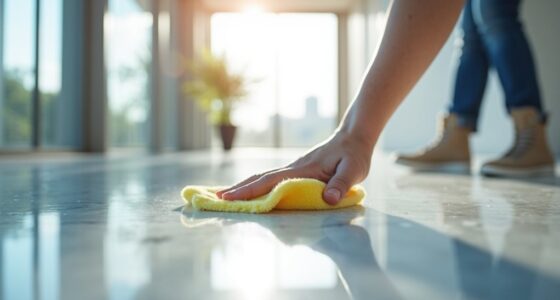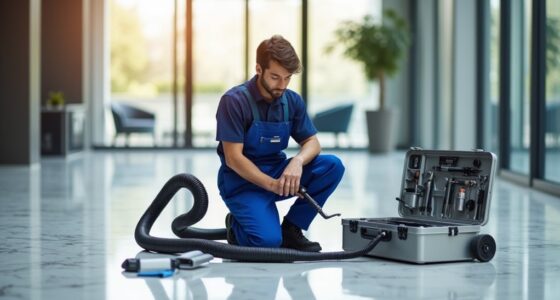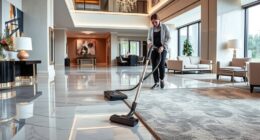When foam builds up in your recovery tank on rubber gym floors, using a defoamer is key to controlling it. Simply add a small amount directly into the tank to break down bubbles quickly without disrupting your cleaning process. This helps prevent overflow, ensures efficient cleaning, and protects your flooring and equipment. Staying on top of foam issues with the right defoamer can save you time and hassle—discover more about choosing and applying the best solutions ahead.
Key Takeaways
- Foam in recovery tanks results from improper mixing of cleaning agents, causing bubbles that spill over and disrupt maintenance.
- Excessive foam can clog filters, slow drying, and damage rubber gym floors over time.
- Defoamers quickly break down bubbles by reducing surface tension, preventing foam buildup.
- Apply a small amount of defoamer directly into the recovery tank for effective foam control.
- Using compatible, appropriate defoamers enhances cleaning efficiency and prolongs the lifespan of gym flooring.
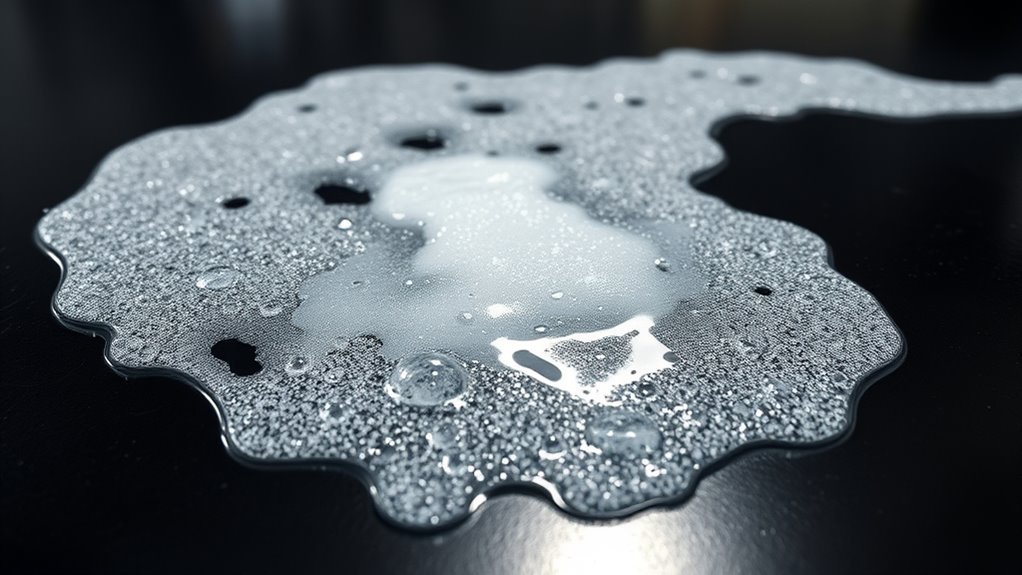
A defoamer for gym floors is an essential product that helps prevent and eliminate foam buildup during cleaning and sealing processes. Foam in recovery tanks on rubber gym floors can be be a common issue, especially when you’re trying to maintain a clean, safe, and visually appealing workout environment. Understanding how foam forms and why it’s problematic is key to effective gym floor maintenance. Cleaning foam often appears during the cleaning process when detergents or cleaning solutions are agitated or mixed improperly. This foam can spill over into recovery tanks, creating a mess and potentially disrupting your cleaning routine. If left unchecked, foam buildup can lead to inefficient cleaning, prolonged drying times, and even damage to the flooring surface over time.
When foam begins to accumulate in your recovery tank, it’s a clear sign that you need a reliable solution. That’s where a quality defoamer comes in. Unlike traditional cleaning agents, a defoamer is designed specifically to break down and reduce foam quickly. It works by disrupting the surface tension of the bubbles, causing them to collapse and preventing excessive foam from forming. Using a defoamer during gym floor maintenance not only keeps your recovery tank clear but also ensures that your cleaning process remains smooth and efficient.
You don’t want to simply ignore foam buildup, as it can interfere with your equipment, clog filters, and cause unnecessary downtime. Instead, keep a bottle of a good defoamer handy, especially when working with rubber gym floors prone to trapping foam. Applying a small amount of defoamer directly into the recovery tank can markedly reduce foam, making it easier to manage. It’s important to choose a product compatible with your cleaning solutions and safe for rubber flooring to avoid any damage or adverse reactions.
Incorporating a defoamer into your gym floor maintenance routine helps you maintain a professional, hygienic environment. It minimizes the risk of foam-related issues while ensuring your cleaning foam doesn’t compromise your equipment or flooring integrity. Regularly monitoring foam levels and applying a defoamer as needed can save you time and effort, leading to better overall gym care. Remember, effective gym floor maintenance isn’t just about scrubbing and sealing; it’s also about managing foam and ensuring your cleaning processes are as efficient as possible. With the right defoamer, you can keep your rubber gym floors looking their best and extend their lifespan while maintaining a safe workout space. Proper foam management is a crucial aspect of maintaining the longevity and safety of rubber gym floors.
Frequently Asked Questions
Can Foam Damage Rubber Gym Flooring Over Time?
Foam buildup can lead to rubber deterioration over time if you don’t address it. As foam accumulates, it can trap moisture and chemicals that weaken the rubber, causing cracks or surface damage. If left unchecked, this deterioration may compromise your rubber gym floors’ integrity. To prevent long-term damage, use a proper defoamer and regularly clean your floors to eliminate foam buildup and protect your investment.
What Are the Environmental Impacts of Using Defoamers?
You’re concerned about the environmental impact of defoamers, right? Many contain chemicals that pose biodegradability concerns and can be toxic to aquatic life if they reach waterways. While they effectively reduce foam, you should consider their long-term effects. Choosing eco-friendly, biodegradable options minimizes harm, protecting ecosystems and ensuring your cleaning practices stay sustainable. Don’t overlook this—your choices today shape the environment of tomorrow.
How Often Should I Apply a Defoamer to Gym Floors?
You should apply a defoamer to your gym floors based on the foam’s appearance and the application frequency recommended by the product manufacturer. Typically, using it at ideal intervals—such as every few hours or after heavy cleaning—helps prevent excessive foam buildup. Monitor the foam levels regularly, and apply the defoamer as needed to maintain a safe, clean workout environment without overusing it.
Are There Natural or Eco-Friendly Defoamer Options?
Yes, there are natural and eco-friendly defoamer options available. You can opt for plant-based solutions that are biodegradable and safe for the environment. These alternatives effectively reduce foam without harsh chemicals, making them ideal for rubber gym floors. Look for products labeled as biodegradable or plant-derived, and always check the manufacturer’s recommendations to guarantee compatibility with your cleaning routine and surface materials.
Will Defoamer Residue Affect Gym Equipment or Footwear?
Imagine stepping onto your gym floor, confident that your equipment safety isn’t compromised. Defoamer residue is typically minimal and won’t damage your equipment or footwear, but persistent foam residue might cause slipping or build-up over time. To keep your gym safe and clean, make certain of proper rinsing after using defoamers, and regularly check for any residue. This way, your gear stays protected, and your workouts remain safe and effective.
Conclusion
Using a defoamer on your gym floors can cut foam issues by up to 80%, keeping your space clean and safe. Remember, a little product goes a long way—just a few drops can make a big difference. Regularly applying a defoamer not only prevents slippery surfaces but also extends the life of your rubber flooring. Keep your gym looking professional and inviting by managing foam effectively; it’s a simple step toward a better workout environment.
